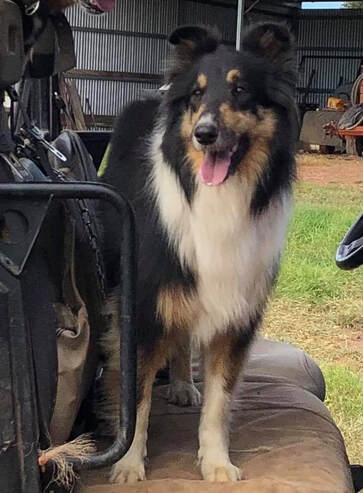What Happened to the Scottish Collie?

The origin of the Scottish Collie has been traced back to the mountainous regions of northern Scotland. Due to the tough terrain of rocks, peaks and steep valleys it was difficult for the shepherds to herd and gather their flocks. Due to the challenging landscape and the shepherd's inability to navigate it easily, it was important to breed a dog who was light and agile to easily cover the mountainous areas, with the endurance to work for hours, herd sheep with a soft eye and highly intelligent to be able to regulate pressure to avoid spooking the sheep which would cause injury as they scrambled through the rocky landscape.
If is also evident that the shepherd needed a herding dog of distinct intelligence to not only execute the shepherd's commands at quite a distance as he was often unable to travel the terrain with the collie. The collies unique ability to independently assess the sheep and move them safely with little guidance from the shepherd was a valuable trait and very sought after. Total obedience to his master was a must and bred into the lines of the classic Scottish Collie.
It is only reasonable to assume that owners of livestock in the 1800`s took great care in breeding collies by selecting for the purpose of the traits needed to perform the duties of a good shepherd dog. Although dogs who lacked the skills to perform the duties were generally not bred, the working Scottish Collie could be found in great abundance.
Unfortunately every dog has his day and eventually the Scottish Collie migrated into Europe and was discovered by those who did not need the skills of the working Scottish Collie but loved the intelligence, beauty and temperament. As a result the collie was bred away from it's original purpose as a working farm collie and morphed into the Rough Collie and Smooth Collie we know today. The rise of the show collie soon followed and the collie was bred to be a flashier breed with a heavier coat, larger in statute and less drive so as to compete in the show ring.
In 1900's the Scottish Collie was also cross bred to the Welsh Collie in Wales and the Border Collie to create a herding dog with the collie obedience and a higher drive for herding the low land areas where more pressure and speed could be used to move the flocks safely. Soon the Scottish Collie dwindled in numbers on the farms while at the same time the Rough Collie and Border Collie grew in popularity.
It is now very difficult to locate the original Scottish Collies from Scotland. At SCPS, we are looking to identify collies worldwide who still carry the traits of the classic working farm collie and breed back to the original Scottish Collie who farmers coveted for their lithe, agile, versatile and highly intelligent characteristics.
If is also evident that the shepherd needed a herding dog of distinct intelligence to not only execute the shepherd's commands at quite a distance as he was often unable to travel the terrain with the collie. The collies unique ability to independently assess the sheep and move them safely with little guidance from the shepherd was a valuable trait and very sought after. Total obedience to his master was a must and bred into the lines of the classic Scottish Collie.
It is only reasonable to assume that owners of livestock in the 1800`s took great care in breeding collies by selecting for the purpose of the traits needed to perform the duties of a good shepherd dog. Although dogs who lacked the skills to perform the duties were generally not bred, the working Scottish Collie could be found in great abundance.
Unfortunately every dog has his day and eventually the Scottish Collie migrated into Europe and was discovered by those who did not need the skills of the working Scottish Collie but loved the intelligence, beauty and temperament. As a result the collie was bred away from it's original purpose as a working farm collie and morphed into the Rough Collie and Smooth Collie we know today. The rise of the show collie soon followed and the collie was bred to be a flashier breed with a heavier coat, larger in statute and less drive so as to compete in the show ring.
In 1900's the Scottish Collie was also cross bred to the Welsh Collie in Wales and the Border Collie to create a herding dog with the collie obedience and a higher drive for herding the low land areas where more pressure and speed could be used to move the flocks safely. Soon the Scottish Collie dwindled in numbers on the farms while at the same time the Rough Collie and Border Collie grew in popularity.
It is now very difficult to locate the original Scottish Collies from Scotland. At SCPS, we are looking to identify collies worldwide who still carry the traits of the classic working farm collie and breed back to the original Scottish Collie who farmers coveted for their lithe, agile, versatile and highly intelligent characteristics.
